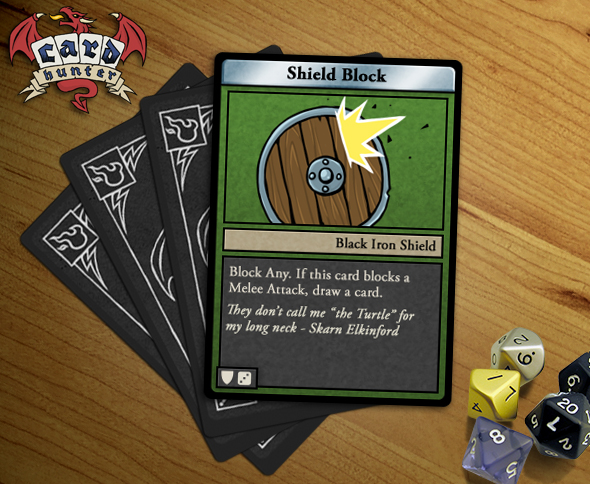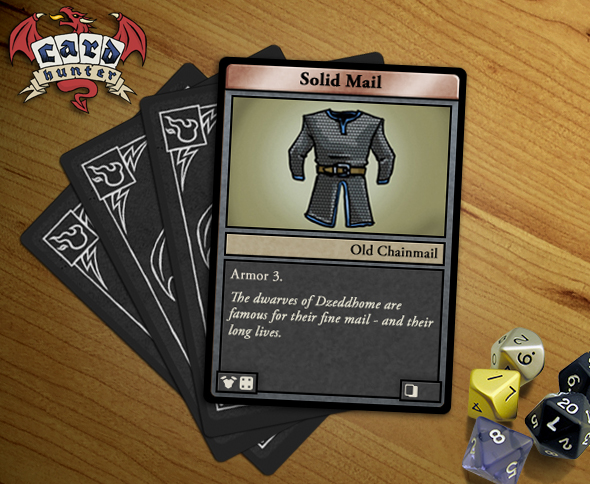OK, this is the third and final instalment of this series of diaries about our reaction cards. In the first one I talked about our old reaction system and, then, in the second one, Skaff talked about his and Richard’s proposal to create a new system based on automatic responsive play. So I think we’ve talked enough about the process by which we got to this system and now I just want to introduce it properly.
There are two main sorts of reactive cards in the game: blocks and armor. We’ve seen a block card in this week’s card preview. In case you missed it, here it is again:
Blocks are great because they will complete nullify an enemy card. In this case, it doesn’t matter what the card is – it could be a melee attack or a spell – it just doesn’t matter, because the shield block will take care of it, assuming you roll high enough. To remind you, what happens is that when your opponent plays a card targeting you, you roll a die (or rather, the computer rolls for you) and, if you roll a 3 or higher, the Shield Block “triggers” and stops their card dead.
What are their down-sides? Well, there are a couple:
- Blocks generally only work once. That means your opponents can draw them out with their weak attacks and then let fly once they’ve left your hand.
- You can only block attacks from someone who isn’t behind you, so watch out for back-stabs.
Hmm, so what if you want long-term all-around protection instead? Well, then you want some Armor!
Armor differs from Blocks in two ways:
- Armor doesn’t stop an attack – it just reduces the damage. The amount of damage it reduces is listed after the Armor keyword on the card. So, Armor 3 reduces the damage by three.
- Armor returns to your hand after it gets used! You can tell that from the little card icon in the lower right of the card. That means that an Armor card presents a long-term problem for your opponent. If you have Solid Mail, for example, and your opponent has a hand full of Attacks that do 3 damage, there’s only a 50% chance that any one of them is going to do anything.
As another bonus, Armor also works from all around, so you don’t need to worry about getting stabbed in the back quite as much.
Why would you ever use a Block card then? Well, Blocks have their advantages too. Although Armor is pretty durable, it’s not as much use if your opponent has a really damaging Attack. If I get hit for 10 damage and only have 7 health, the fact that my Armor reduced the damage by 3 isn’t going to seem that exciting. Additionally, Blocks stop cards dead – they don’t just reduce damage. If an annoying Wizard tries to Teleport me, an Armor card isn’t much use because Teleport doesn’t do any damage anyway. But a Block might be just the thing.
I think you can probably see how useful both Blocks and Armor are. But what’s to stop you just loading up with a ton of Armor cards, sitting back and waiting to bore your opponent to death? Well, for one thing, although Armor is useful, it does eat up a spot in your hand. You might remember that you can only keep two cards at the end of each round. Too much Armor in your deck, and you’ll end up throwing a lot of cards out because you just can’t use them. Additionally, every time an Armor card triggers, it reveals itself to your opponent. A smart game designer might make sure that there are a bunch of cards in the game that force players to discard cards that have been revealed…
So Armor is plenty counter-able and so are Blocks. But they are definitely useful parts of a defensively minded character’s arsenal. And these are just the simplest examples of our reaction cards. There are lots of other ways we use this system to create interesting cards and strategies. We’ll be revealing those over the coming weeks in our card previews.
Meanwhile, next week we’re going to take a break from game system design and talk about the game from a completely different point of view.





September 28th, 2011 at 1:52 pm
Gee, I didn’t realize Shield Block would stop things like Teleport. What fun!
You’ve previously indicated that most cards are able to target allies as well as enemies. I might want my own wizard to teleport me out of a lava pit — how do blocks and armors react to “friendly fire”?
September 28th, 2011 at 3:03 pm
*response to mightymushroom*
Well the block card does say “Block Any” which i do find interesting from a magic standpoint, blocking a magic spell might be a little weird thinking about it. Also i dont assume you would be blasting your own allies with your magic spells unless your in the midst of your wizards Area of effect spell in which case im sure you would block it just the same. As for healing spells im sure there is the case that lets ally friendly spells through to help you.
All in all, sounds great. Cant wait to make my warrior tank so full of armor he cant move.
September 28th, 2011 at 4:50 pm
@ SurgeonFish,
I’m not 100% sure it’s that simple, so I asked. It seems like a lot of extra rules – checking whether “ally” or “damaging” – for a game that lets you blithely Thrust a dagger in your friend’s gullet. >:D Why should the defense have friendly fire protections but not the offense?
September 28th, 2011 at 6:04 pm
Is it really so easy to ‘[load] up with a ton of Armor cards’ when the equipment the characters are wearing define the cards in their deck? I presume that you can’t wear more than one suit of armor, and that the suit of armor isn’t going to give your character a ‘ton’ of armor cards…
September 28th, 2011 at 11:41 pm
Yeah, you don’t block cards targeting you from allies. Your armor will trigger if you get caught in a blast from a fireball that an ally cast though.
The reason why we let you stab an ally but don’t have the block trigger is that stabbing an ally is under your control and you may have a reason to do it. Triggering a block is not under your control and 99% of the time you don’t want it to trigger. It would be super-annoying if the game chose to have you use your Shield Block to block a healing spell, for example.
September 28th, 2011 at 11:42 pm
@Melodatron – it’s a good point. It’s pretty hard to stack your deck with Armor cards. That said, there may well be classes or items that allow you to take more Armor than you normally would.
September 30th, 2011 at 4:23 am
Thanks for the new update! I really like the system as a whole, armor looks like a lot of fun.
October 5th, 2011 at 12:38 pm
Why have the block be an automatic reaction?
Why not let the player choose whether to spend the block on that dagger thrust or keep it for that dragon’s fire blast?
October 6th, 2011 at 12:20 am
@zipdrive: you should check out the previous diary entries linked to at the top of this blog post. Basically, we did have a system where you could choose your response and it was too slow.
October 6th, 2011 at 4:38 pm
Well, I’ve read all the diary entries! I only recall the Boosting discussion. I may be getting old, though…
October 6th, 2011 at 9:38 pm
@zipdrive: The main point we were trying to get across was that we had a system where you could choose to block or not and it was fun and had plenty of strategy. The problem was that it just took too long. Many games were going 45-60 minutes, which is a problem when you want deck building to be an integral part of your game too. That’s why we tried to come up with an alternative that retained the feel of attack and defense but got it done much more quickly.